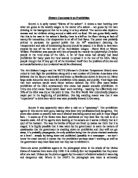Source E was apparently taken after a raid on a “speakeasy”. The prohibition agents in this source have guns, making them look very professional and dangerous. The photo also shows us exactly how much alcohol was being stored and sold in these illegal bars – it seems as if the boxes have been positioned so they look like the raid is on a massive scale. All of the agents were looking at the camera so it seems unlikely that is it spur of the moment. The way the bottles of liquor are lined up makes me think that it is staged. It is highly possible that it was taken by the government to scare the owners of speakeasies that the government is cracking down on prohibition and they will not get away. It’s probably propaganda, the only problem being that the photo showed weakness on a level – simply by being taken and published (possibly in a newspaper – we don’t know the exact source) it shows that the prohibition perhaps wasn’t working as well as the government may have liked and that they had to reinforce it.
There are seven prohibition agents in the photograph when in the whole of the Unites States of America there were only 1500. It is unlikely (but not impossible) that they were all at one raid. Unless (as the photo suggests by the amount of alcohol seized) it was a big and dangerous raid. Where in the 1920’2 the photograph was taken is extremely important to the viewers understanding of why it was taken – whether it was at the end of the 20’s as desperation – trying to reassure the public of a failing law, or at the beginning – telling people that it was working and would continue to work as long as the outcome was like that photograph, lots of liquor seized and the cracking down on crime.
By showing this photo to the general public maybe the government hoped to achieve shock among the citizens of the USA as to exactly how much illegal alcohol was being passed, but also maybe to create reassurance that the prohibition agents were doing their job. The fact that the photo only shows the raid on the speakeasy after it happened does not help us to see exactly what went on in the raid. It merely shows us (in an almost definitely bias view) the glory of the agents after they succeeded.
The First World War played a big part in prohibition. It was meant to decrease violence, crime and anti-social behaviour among the public. The main aim of prohibition – on a much larger level was to make the USA a more positive place to live in. when you look at sources A and B you can see that (from these sources) prohibition was a success. Anti-social behaviour and the mistreating of women could no longer happen as no-one could know that these men were drunk or had been drinking or they would be in trouble with the law, basically eliminating this problem entirely. Another way we could look at it being a success is by looking at the intake of alcohol during the prohibition period. In 1910 about 1.6 gallons of alcohol (pure) was consumed per person. In 1921 however it had decreased to just 0.2 gallons per person. Almost decreasing by 90% - only rising later on when the government got lax on prohibition. Source B is a poster released in 1910 by the anti-saloon league saying how too many men were spending too much money on too much alcohol. If by 1921 (just eleven years later) alcohol consumption had decreased by 90% nobody could say that it hadn’t worked on some level. I think that the prohibition worked because people wanted it to work.
People in the rural areas especially backed it. There were few speakeasies, but many of these smaller places had had some level of local prohibition for a while now and had grown accustomed to it. These parts of the USA were dry for many years after the prohibition amendment was repealed. Source C could either be taken negatively – showing that more drink related arrests happened in this period or it could be taken positively, arguing that the police were doing their job and catching more people that weren’t abiding by the law.
We could also say from the same sources and information that prohibition failed if the governments aim was to reduce drinking. During prohibition the amount of illegal speakeasies doubled the amount of legal saloons before the prohibition amendment was put in place. Gangsters made lots of money by bootlegging and it opened up a lot of windows of opportunities for gangsters such as Capone or O’Bannion. In five years of prohibition (source C) shows that the amount of arrests for drunk behaviour almost trebled. Bribery was a strong contender in getting off the hook (Source F – John Torrio bribing Bill Thompson). The police failed to follow through arrests – or 6902 cases involving the breaking of the law in Source D about 6074 were dropped. 5 people held for alcohol related crimes were held for trial. A film we watched called “some like it hot” shows several gang murders true of every day life in Chicago. The city was ruled by gangsters and this only stopped when Capone went to jail in 1031 for tax evasion. Over the prohibition period the number of federal convicts went up to over 500%. Prohibition had failed. Failed in its aims to make the USA a more friendly, better place to live and most importantly – to reduce crime rates.







